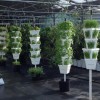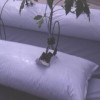 The importance of using an open shade structure for hydroponic crop culture in Florida has recently increased. Prior to the turn of the century, hydroponic culture in Florida was done inside a greenhouse structure, but it has now expanded to several other types of structures. In addition to greenhouses, production now exists in high tunnels, insect screens or net houses, and open shade-covered structures. In southern parts of Florida, outdoor hydroponic systems without any structure are becoming more common. In those cases, many operations use a polypropylene cover for freeze protection. Diversifying structures stems from growers’ desires to extend the season to meet consumer demand for a longer time period. The purpose of this publication is to indicate what crops have been successfully grown under shade in northern Florida at various times of the year. This 4-page fact sheet was written by Daniel K. Fenneman, Robert C. Hochmuth, Wanda L. Laughlin, and Sean R. McCoy, and published by the UF Department of Horticultural Sciences, November 2014.
The importance of using an open shade structure for hydroponic crop culture in Florida has recently increased. Prior to the turn of the century, hydroponic culture in Florida was done inside a greenhouse structure, but it has now expanded to several other types of structures. In addition to greenhouses, production now exists in high tunnels, insect screens or net houses, and open shade-covered structures. In southern parts of Florida, outdoor hydroponic systems without any structure are becoming more common. In those cases, many operations use a polypropylene cover for freeze protection. Diversifying structures stems from growers’ desires to extend the season to meet consumer demand for a longer time period. The purpose of this publication is to indicate what crops have been successfully grown under shade in northern Florida at various times of the year. This 4-page fact sheet was written by Daniel K. Fenneman, Robert C. Hochmuth, Wanda L. Laughlin, and Sean R. McCoy, and published by the UF Department of Horticultural Sciences, November 2014.
http://edis.ifas.ufl.edu/hs1228
Tag: Dan Fenneman
Production Systems: Florida Greenhouse Vegetable Production Handbook, Vol 3 (HS785/CV263)
 Worldwide, commercial greenhouse vegetable producers currently use numerous production systems. Among the more prevalent include lay-flat bag or upright container culture, trough culture, rockwool, vertical culture, nutrient film technique (NFT), and ground (in-soil) culture. Many modifications of these basic production systems are presently in use, and most are appropriate for Florida, except for unamended ground culture. This 8-page fact sheet was written by Dan Fenneman, Michael Sweat, George Hochmuth, and Robert Hochmuth, and published by the UF Department of Horticultural Sciences, October 2012.
Worldwide, commercial greenhouse vegetable producers currently use numerous production systems. Among the more prevalent include lay-flat bag or upright container culture, trough culture, rockwool, vertical culture, nutrient film technique (NFT), and ground (in-soil) culture. Many modifications of these basic production systems are presently in use, and most are appropriate for Florida, except for unamended ground culture. This 8-page fact sheet was written by Dan Fenneman, Michael Sweat, George Hochmuth, and Robert Hochmuth, and published by the UF Department of Horticultural Sciences, October 2012.
http://edis.ifas.ufl.edu/cv263